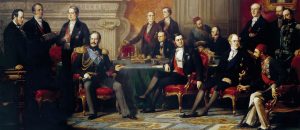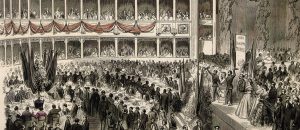Mithat Pasha is the 19th-century’s most reformist and most tragic statesman, who gifted the Ottoman Empire its first constitution (Kanun-i Esasi) but paid for this revolutionary step first with exile and then with his life. His rise in the corridors of Dolmabahçe Palace represents the peak of the constitutional struggle against absolute monarchy, while his conflict with Sultan Abdülhamid II and his suspicious death in the Taif dungeons reveal how dangerous and bloody this struggle was. Mithat Pasha is the dramatic story of an intellectual who started as a “Hero of Liberty” but died as an “enemy of the state.”
From a Reformist Governor to the Pinnacle of the State
Mithat Pasha was a new generation Ottoman bureaucrat who started his career in the provinces and climbed to the pinnacle of the state through his own abilities and vision. The successes he demonstrated while serving as governor in the empire’s most challenging provinces, such as Tuna (Danube), Baghdad, and Syria, brought him to the political stage in Istanbul. In the places where he served, he laid the foundations for agricultural banks (Memleket Sandıkları – Homeland Chests), initiated modern municipal services, and established local assemblies to ensure public participation in governance. These experiences instilled in him the idea that the salvation of the empire was only possible through a constitutional monarchy (meşruti monarşi) where the people participated in governance and the Sultan’s powers were limited by a constitution. This idea made him one of the most dangerous men for the period’s absolutist order.
Where the people participated in governance and the Sultan’s powers were limited by a constitution, a concept unthinkable in the absolute power structure of Topkapı Palace.
The Man Who Overthrew Two Sultans: Coup and Constitutionalism
The year 1876 became a turning point in Mithat Pasha’s career and in Ottoman history. At a time when the Empire was struggling with a major crisis in the Balkans and the treasury had gone bankrupt, Mithat Pasha and statesmen who thought like him (Hüseyin Avni Pasha, Mütercim Rüşdi Pasha) overthrew Sultan Abdülaziz—whom they held responsible for the dire situation—in a military coup on May 30, 1876. This was the first modern coup in Ottoman history where the army and bureaucracy combined to depose a Sultan. Their goal was to install the Crown Prince, Murad V, who had promised to declare constitutional rule (meşrutiyet).
However, this plan fell through when Murad V lost his mental balance. This time, Mithat Pasha sat down at the negotiating table with another prince, Abdülhamid. In exchange for Abdülhamid’s promise to proclaim the constitution (Kanun-i Esasi) and convene the parliament (Meclis-i Mebusan), Mithat Pasha ensured the deposition of Murad V and Abdülhamid’s ascension to the throne. On December 23, 1876, during Mithat Pasha’s term as Grand Vizier (Sadrazamlık), the first constitution in Ottoman history was announced to the public at the Bâb-ı Seraskeri in front of Dolmabahçe Palace. This was Mithat Pasha’s victory and the theoretical end of absolute monarchy.
The Conflict Between the Sultan and the Grand Vizier, and Exile
Mithat Pasha’s victory was very short-lived. Sultan Abdülhamid II, who had been forced to accept the constitution upon ascending the throne, actually had no intention of sharing power with the parliament and the constitution. He viewed Grand Vizier Mithat Pasha as the biggest threat to his own authority. The tension between the two statesmen rapidly escalated. Mithat Pasha’s insistence on governing the state from the Sublime Porte (Bâb-ı Âli) clashed with the Sultan’s desire to recentralize power in the palace. Finally, only 44 days after the declaration of the constitution, on February 5, 1877, Sultan Abdülhamid II summoned Mithat Pasha to Dolmabahçe Palace. Accusing him of being responsible for the death of Sultan Abdülaziz and intending to establish a republic (cumhuriyet), he dismissed him from the Grand Vizierate and sent him into exile abroad, utilizing the authority granted to him by the constitution. This was the first and most crucial step Sultan Abdülhamid took toward consolidating his absolute power.
Figures of an Era: The Shapers of Transformation
The spies, the pashas, the revolutionaries… The late Ottoman era was a chessboard of powerful figures. Meet the key players who defined this age of intrigue and transformation.
MEET THE FIGURES OF AN ERA →
Taif Dungeon and Suspicious Death
After living in exile in Europe for several years, Mithat Pasha was appointed as governor of Izmir, reportedly after being pardoned by the Sultan. However, this was a trap. Shortly thereafter, he was arrested to be tried in the Yıldız Court, which was established to judge those responsible for the death of Sultan Abdülaziz. At the end of this court—a political vendetta lacking legal basis—Mithat Pasha and the other Pashas were sentenced to death. Due to pressure from Europe, Sultan Abdülhamid II commuted this sentence to life imprisonment, and Mithat Pasha was exiled to Taif Castle in Arabia. On May 8, 1884, he was found strangled in his cell in the Taif dungeon. Although the official explanation was “carbuncle inflammation,” it is widely accepted by historians that he was murdered by the order of the Sultan.
An Idealist’s Tragic Legacy
In conclusion, Mithat Pasha’s story is the tragedy of one of the brightest minds of Ottoman modernization becoming a victim of the very system he created and the Sultan he placed on the throne. He was an idealist who tried to save the empire with a constitutional order; but he faced Sultan Abdülhamid II, a political actor who was more cunning and patient than himself and who had no intention of sharing power. Mithat Pasha’s rise in the corridors of Dolmabahçe and his fall in the Taif dungeons are the most concrete evidence of how bloody and ruthless the struggle for liberty and constitution was in the Ottoman Empire.
The Archives Await
The story you’ve just read is a single thread in a rich historical tapestry. The Dolmabahçe Journal holds countless other narratives of art, power, and transformation waiting to be discovered.
READ MORE FROM THE JOURNAL →



















